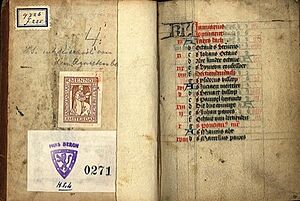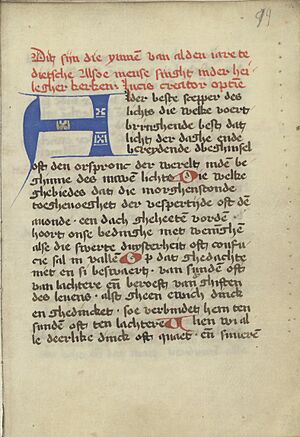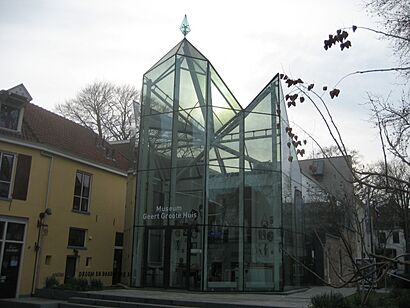Geert Groote facts for kids

Gerard Groote (born October 1340 – died August 20, 1384) was a famous Dutch Catholic leader. He was known as a popular preacher. He also started a group called the Brethren of the Common Life. Gerard Groote was very important in a religious movement called the Devotio Moderna.
Contents
Gerard Groote's Life Story
Early Life and Schooling
Gerard Groote was born in the city of Deventer in the Netherlands. His father held an important job in the city. When Gerard was only fifteen, he went to the University of Paris to study.
At the university, he learned about philosophy and theology. He also studied church law, medicine, and astronomy. He finished his studies in 1358. In 1362, he became a teacher at a school in Deventer.
His Religious Journey
After his studies, Groote moved to Cologne. He taught philosophy and theology there. He also received special church positions in Utrecht and Aachen. In 1366, he went on a secret trip to see Pope Urban V in Avignon.
At this time, Groote was living a very fancy and worldly life. But in 1374, something big changed for him. He became very sick, and a friend named Henry de Calcar talked to him about his life. This made Groote decide to give up his worldly pleasures.

In 1374, Groote turned his family home in Deventer into a place for poor women. For several years, he lived simply at a monastery. In 1379, he became a deacon and started preaching. He traveled all over the diocese of Utrecht.
Many people loved his sermons. They would leave their work and meals to hear him speak. The churches were often too small to hold everyone. The bishop of Utrecht supported Groote's preaching.
However, Groote also spoke out against bad behavior among both regular people and church leaders. This made some clergy members angry. They accused him of teaching wrong ideas. Groote said that his sermons were always about Jesus and followed Catholic teachings.
The bishop was convinced to stop anyone who was not a priest from preaching. This rule affected Groote. He tried to appeal to Pope Urban VI, but it did not work. It seems he was able to preach again later in his life.
Around 1381, Groote visited a famous mystic named John of Ruysbroeck. This visit made Groote interested in the Augustinian canons' way of life. Near the end of his life, some of his followers wanted to form a religious order. Groote decided they should become Canons Regular of St. Augustine.
Groote died from the plague in 1384. He caught the illness while caring for sick people. He was only 44 years old. Groote was also a well-known writer. He made an important translation of a book of hours into Middle Dutch. This translation was used many times for centuries.
The Brethren of the Common Life
Many young men were drawn to Groote's teachings. He sent some to his schools. Others helped by copying good books. He taught all of them how to live a truly Christian life.
Groote and Florence Radewyns, his favorite student, started the group called the Brethren of the Common Life in Zwolle. In 1387, a place was found at Windesheim, about 24 kilometers (15 miles) north of Deventer. Here, a monastery was built. This monastery became the start of the Windesheim Congregation. This group grew to include nearly one hundred houses. It also led many church reforms in Germany during the 1400s.
Groote's communities quickly spread through the Netherlands and Germany. He focused all his attention on them. He planned for his followers to become canons regular. But it was Radewyns, his successor, who made this plan happen two years later at Windesheim.
The Devotio Moderna Movement
A religious movement called the Modern Devotion, or Devotio Moderna, began in the Netherlands. It was started by Groote and Florens Radewyns in the late 1300s. For Groote, the main goal was to find inner peace. This peace came from putting oneself aside and focusing on "ardour" (strong feeling) and "silence." This was the core of the "New Devotion."
It was important to quietly think about Christ's suffering and forgiveness. People also meditated on their own death, the Last Judgment, heaven, and hell.
During the 1400s, the Modern Devotion spread across the Netherlands and Germany. Its ideas were shared through books like The Imitation of Christ by Thomas à Kempis. More and more people could read these books. Small artworks, like diptychs (two-paneled paintings), were also popular. They helped people focus during their private prayers.
Gerard Groote's Legacy
There is a school in Amsterdam named Geert Groote College.
See also
 In Spanish: Gerardo Groote para niños
In Spanish: Gerardo Groote para niños
- Florens Radewyns
- Hendrik Mande


